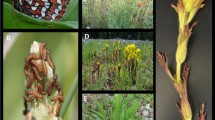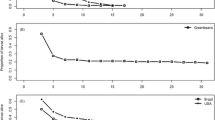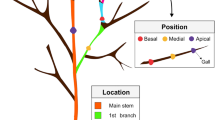Abstract
Pedicularis semibarbata is apparently an obligate hemiparasite of coniferous trees. It is also a facultative parasite ofLupinus fulcratus from which we find that it obtains quinolizidine alkaloids, principally α-isolupanine. As a result, a single population ofP. semibarbata contains both alkaloidrich and alkaloid-free plants. The butterflyEuphydryas editha naturally oviposits on both plant types. This butterfly population, which is the principal herbivore attackingP. semibarbata at this site, is known to contain two morphs. Individuals of a specialist morph discriminate when ovipositing among individualP. semibarbata plants and produce offspring that survive better on accepted than on rejected plants. Those of a generalist morph accept allP. semibarbata plants and produce offspring that survive equally well on plants accepted or rejected by the discriminating morph. Because of the existence of this complex variation among the butterflies, the presence of naturally laid eggs on alkaloid-containing plants still leaves the possibility that the alkaloids may defend the plants against the specialist morph. In experiments on both oviposition preference and larval performance in early instars, we failed to detect any correlation between alkaloid content of a plant and either its acceptability to or suitability for the discriminating morph of the insect. Alkaloid presence in the host-plant population, achieved through root parasitism, is currently neither subject to strong insect-mediated selection nor a major cause of selection on the insects.
Similar content being viewed by others
References
Atsatt, P.R. 1977. The insect herbivore as a predictive model in parasitic seed plant biology.Am. Nat. 111:579–586.
Bentley, M.D., Leonard, D.E., Reynolds, E.K., Leach, S., Beck, A.B., andMurakoshi, I. 1984. Lupine alkaloids as larval feeding deterrents for spruce budworm,Choristoneum fumiferana (Lepidoptera: Tortricidae).Ann. Entomol. Soc. Am. 77:398–400.
Breedlove, D.E., andEhrlich, P.R. 1972. Coevolution: Patterns of legume predation by a lycaenid butterfly.Oecologia 10:99–104.
Dolinger, P.M., Ehrlich, P.R., Fitch, W.L., andBreedlove, D.E. 1973. Alkaloid and predation patterns in ColoradoLupine populations.Oecologia 23:191–204.
Dreyer, D.L., Jones, K.C., andMolyneux, R.J. 1985. Feeding deterrency of some pyrrolizidine, indolizidine, and quinolizidine alkaloids toward pea aphid (Acyrthosiphon pisum) and evidence for phloem transport of indolizidine alkalod swainsonine.J. Chem. Ecol. 11:1045–1051.
Harris, G.H. 1987. Iridoid and alkaloid chemistry ofCastilleja. Dissertation. Colorado State University, Fort Collins, Colorado.
Harris, G.H., andStermitz, F.R. 1987. Transfer of pyrrolizidine and quinolizidine alkaloids toCastilleja (Scrophulariaceae) hemiparasites from composite and legume host plant.J. Chem. Ecol. 13:1917–1925.
Harrison, S., andKarban, R. 1986. Effects of an early-season folivorous moth on the success of a later-season species, mediated by a change in the quality of the shared host,Lupinus arboreus Sims.Oecologia 69:354–359.
Johnson, N.D., andBentley, B.L. 1988. Effects of dietary protein and lupine alkaloids on growth and survivorship ofSpodoptera eridania.J. Chem. Ecol. 14:1391–1403.
Kinghorn, A.D., andBalandrin, M. F. 1984. Quinolizidine alkaloids of the leguminosae: Structural types, analysis, chemotaxonomy, and biological activities, p. 126,in S.W. Pelletier (ed.). Alkaloids: Chemical and Biologial Perspectives. Vol. 2, John Wiley & Sons, New York.
Mackay, D.A. 1985. Prealighting search behavior and host plant selection by ovipostingEuphydryas editha butterflies.Ecology 66:142–151.
Ng, D. 1987. Consequences of variation in the ability to use different individuals of a host plant species in the nymphalid butterflyEuphydryas editha. Dissertation. University of Texas, Austin, Texas.
Ng, D. 1988. A novel level of interactions in plant-insect systems.Nature 334:611–612.
Rausher, M.D., Mackay, D.A., andSinger, M.C. 1981. Pre-alighting and post-alighting host discrimination byEuphydryas editha butterflies: The behavioral mechanism causing clumped distribution of egg clusters.Anim. Behav. 29:1220–1228.
Singer, M.C. 1983. Determinants of multiple host use in a phytophagous insect population.Evolution 37:389–403.
Singer, M.C. 1986. The definition and measurement of oviposition preference in plant-feeding insects, pp. 65–94,in J.R. Miller and T.A. Miller (eds.) Insect-Plant Interactions. Springer-Verlag, New York.
Ubaev, Kh., Yuldashev, P.Kh., andYunusov, S. Yu. 1963.Pedicularis olgae alkaloids.Chem. Abstr. 59:15602.
White, T.C.R. 1978. The importance of a relative shortage of food in animal ecology.Oecologia 33:71–86.
Wink, M. 1985. Chemische Verteidigung der Lupinen: Zur Biologischen Bedeutung der Chinolizidinalkaloide.Plant Syst. Evol. 150:65–81.
Wink, M. 1987. Chemical ecology of quinolizidine alkaloids, pp. 524–533,in G.R. Waller (ed.) Allelochemicals: Role in Agriculture and Forestry. American Chemical Society, Washington D.C.
Wink. M., andRömer, P. 1986. Acquired toxicity—the advantages of specializing on alkaloidrich lupins toMacrosiphon albifrons (Aphidae).Naturwissenschaften 73:210–212.
Author information
Authors and Affiliations
Rights and permissions
About this article
Cite this article
Stermitz, F.R., Belofsky, G.N., Ng, D. et al. Quinolizidine alkaloids obtained byPedicularis semibarbata (Scrophulariaceae) fromLupinus fulcratus (Leguminosae) fail to influence the specialist herbivoreEuphydryas editha (Lepidoptera). J Chem Ecol 15, 2521–2530 (1989). https://doi.org/10.1007/BF01014728
Received:
Accepted:
Issue Date:
DOI: https://doi.org/10.1007/BF01014728




